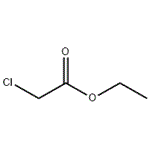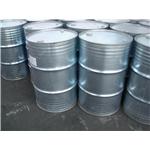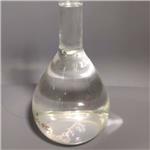- Ethyl chloroacetate
-

- $1.50 / 1g
-
2023-07-27
- CAS:105-39-5
- Min. Order: 1g
- Purity: 99.0% Min
- Supply Ability: 100 Tons
- Ethyl chloroacetate
-

- $0.00 / 200kg
-
2023-06-26
- CAS:105-39-5
- Min. Order: 1kg
- Purity: 99.0%
- Supply Ability: 20tons
- Ethyl chloroacetate
-

- $10.00 / 1KG
-
2023-03-06
- CAS:105-39-5
- Min. Order: 1KG
- Purity: 99.8%
- Supply Ability: 10000kg
|
| | Ethyl chloroacetate Basic information |
| | Ethyl chloroacetate Chemical Properties |
| Melting point | -26 °C (lit.) | | Boiling point | 143 °C (lit.) | | density | 1.145 g/mL at 25 °C (lit.) | | vapor density | 4.23 (vs air) | | vapor pressure | 10 mm Hg ( 38 °C) | | refractive index | n20/D 1.421(lit.) | | Fp | 150 °F | | storage temp. | Store below +30°C. | | solubility | 12.3g/l | | form | Liquid | | color | Clear colorless | | Odor | Extremely irritating; fruity; pungent | | explosive limit | 2.6%(V) | | Water Solubility | 20 g/L (20 ºC) | | Merck | 14,3783 | | BRN | 506455 | | Dielectric constant | 11.6(20℃) | | Stability: | Stable. Incompatible with acids, bases, oxidizing agents, reducing agents. Flammable. | | LogP | 0.940 | | CAS DataBase Reference | 105-39-5(CAS DataBase Reference) | | NIST Chemistry Reference | Ethyl chloroacetate(105-39-5) | | EPA Substance Registry System | Ethyl chloroacetate (105-39-5) |
| Hazard Codes | T,N | | Risk Statements | 23/24/25-50-10 | | Safety Statements | 45-61-7/9-16 | | RIDADR | UN 1181 6.1/PG 2 | | WGK Germany | 2 | | RTECS | AF9110000 | | Autoignition Temperature | 452 °C | | TSCA | Yes | | HS Code | 2915 40 00 | | HazardClass | 6.1 | | PackingGroup | II | | Hazardous Substances Data | 105-39-5(Hazardous Substances Data) | | Toxicity | LD50 orally in Rabbit: 180 mg/kg LD50 dermal Rat 161 mg/kg |
| | Ethyl chloroacetate Usage And Synthesis |
| Description | Ethyl chloroacetate is a water-white liquidwith a pungent, fruity odor. Molecular weight = 122.56;Boiling point = 145℃. Freezing point = - 27℃; Flashpoint = 64℃. Hazard Identification (based on NFPA-704 MRating System): Health: 3, Flammability 3, Reactivity 0.Insoluble in water. | | Chemical Properties | Ethyl chloroacetate is a colourless liquid with a pungent, fruity odor.Ethyl chloroacetate has a vapor pressure of 10mmHg at 38 °C (Lewis, 1997). It is insoluble in water, but miscible with alcohol, ether, and acetone (Lide, 1998); it is soluble in benzene (Lewis, 1997). Ethyl chloroacetate readily decomposes in hot water and alkalis (Lewis, 1997). | | Uses | Ethyl chloroacetate is a reagent used in the preparation of 5 member heterocycles. It is used as pharmaceutical and organic intermediate. It is used as a solvent for organic synthesis and the production of pesticides (such as sodium fluoroacetate). | | Preparation | Ethyl chloroacetate is synthesized by esterification of chloroacetic acid and ethanol under the catalysis of sulfuric acid. The reaction equation is as follows:
ClCH2COOH+C2H5OH[H2SO4]→ClCH2COOC2H5+H2O
Reaction: Add chloroacetic acid, ethanol and benzene into the esterification pot, turn on the stirrer, slowly add sulfuric acid, heat to reflux, continuously steam out the benzene-water azeotrope, and de-esterify the water generated by condensation and separator layering, Benzene is refluxed into the esterification pot, cooled and discharged when there is no more water to steam out, the crude ester is washed with saturated sodium bicarbonate solution and water to neutrality, dried with anhydrous calcium chloride, distilled, and collected The fraction at 144-146°C is the finished product of ethyl chloroacetate, the content is ≥99.0%, and the yield is 85%. | | Synthesis Reference(s) | Tetrahedron, 23, p. 359, 1967 DOI: 10.1016/S0040-4020(01)83321-4 | | General Description | A clear colorless liquid with a pungent odor. Flash point 100°F. Denser than water and insoluble in water. Vapors heavier than air. | | Air & Water Reactions | Highly flammable. Slow hydrolysis to acidic products will cause slow corrosion of common metals. No hazard involved. [USCG, 1999]. | | Reactivity Profile | Ethyl chloroacetate is a chlorinated ester. Esters react with acids to liberate heat along with alcohols and acids. Strong oxidizing acids may cause a vigorous reaction that is sufficiently exothermic to ignite the reaction products. Heat is also generated by the interaction of esters with caustic solutions. Flammable hydrogen is generated by mixing esters with alkali metals and hydrides. | | Hazard | Strong irritant to eyes. | | Health Hazard | Inhalation causes irritation of mucous membrane, headache, and nausea. Contact with liquid causes extreme eye irritation and conjunctivitis; irritates skin if not removed at once. Ingestion causes irritation of mouth and stomach. | | Fire Hazard | Special Hazards of Combustion Products: Irritating, toxic hydrogen chloride and phosgene may be generated in fires. | | Chemical Reactivity | Reactivity with Water Very slow, not hazardous; Reactivity with Common Materials: Slow hydrolysis to acidic products; Stability During Transport: Stable; Neutralizing Agents for Acids and Caustics: Not pertinent; Polymerization: Not pertinent; Inhibitor of Polymerization: Not pertinent. | | Safety Profile | oison by skin contact
and subcutaneous routes. A severe eye
irritant. Questionable carcinogen with
experimental neoplastigenic data.Flammable liquid; a dangerous fire hazard
when exposed to heat or flame; can react
vigorously with oxidizing materials. Will
react with water or steam to produce toxic
and corrosive fumes. Vigorous reaction with
sodium cyanide. To fight fire, use water,
foam, CO2, dry chemical. When heated to
decomposition it emits highly toxic fumes of
cl-. | | Potential Exposure | Used to make rodenticides, dyes, and
other chemicals. Also used as a military poison | | First aid | If this chemical gets into the eyes, remove anycontact lenses at once and irrigate immediately for at least15 min, occasionally lifting upper and lower lids. Seek medical attention immediately. If this chemical contacts theskin, remove contaminated clothing and wash immediatelywith soap and water. Seek medical attention immediately. Ifthis chemical has been inhaled, remove from exposure,begin rescue breathing (using universal precautions, including resuscitation mask) if breathing has stopped and CPR ifheart action has stopped. Transfer promptly to a medicalfacility. When this chemical has been swallowed, get medical attention. Give large quantities of water and inducevomiting. Do not make an unconscious person vomit.Medical observation is recommended for 24- 48 h afterbreathing overexposure, as pulmonary edema may bedelayed. As first aid for pulmonary edema, a doctor orauthorized paramedic may consider administering a corticosteroid spray | | storage | (1) Color Code—Red: Flammability Hazard: Storein a flammable liquid storage area or approved cabinetaway from ignition sources and corrosive and reactivematerials. (2) Color Code—Blue: Health Hazard/Poison:Store in a secure poison location. Prior to working with thischemical you should be trained on its proper handling andstorage. Store in tightly closed containers in a cool, wellventilated area away from oxidizers, strong acids, strongbases, reducing agents, heat, and sources of ignition. Wherepossible, automatically pump liquid from drums or otherstorage containers to process containers. Drums must beequipped with self-closing valves, pressure vacuum bungs,and flame arresters. Use only nonsparking tools and equipment, especially when opening and closing containers ofthis chemical. Sources of ignition, such as smoking andopen flames, are prohibited where this chemical is used,handled, or stored in a manner that could create a potentialfire or explosion hazard. Wherever this chemical is used,handled, manufactured, or stored, use explosion-proof electrical equipment and fittings. | | Shipping | UN1181 Ethylchloroacetate, Hazard class: 6.1;
Labels: 6.1-Poisonous materials, 3-Flammable liquid. | | Purification Methods | Shake the ester with satutated aqueous Na2CO3 (three times), aqueous 50% CaCl2 (three times) and saturated aqueous NaCl (twice). Dry it with Na2SO4 or MgSO4 and distil it. [Beilstein 2 IV 481.] LACHRYMATORY. | | Incompatibilities | May form explosive mixture with air.
Incompatible with strong bases; strong acids; reducing
agents. Moisture, water, and steam contact forms toxic and
corrosive fumes. Violent reaction with oxidizers, alkaline
earth metals (barium, calcium, magnesium, strontium, etc.),
alkaline metals, sodium cyanide. Attacks metals in the presence of moisture. | | Waste Disposal | Dissolve or mix the material
with a combustible solvent and burn in a chemical incinerator equipped with an afterburner and scrubber. All federal,
state, and local environmental regulations must be
observed. Consult with environmental regulatory agencies
for guidance on acceptable disposal practices. Generators
of waste containing this contaminant (≥100 kg/mo) must
conform with EPA regulations governing storage, transportation, treatment, and waste disposal. |
| | Ethyl chloroacetate Preparation Products And Raw materials |
|